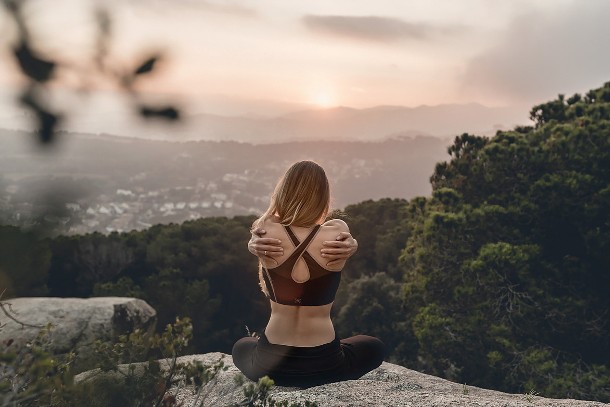I recently began wearing baggy shirts to yoga class—the kind that fall down around your arms when you are in a down dog.
Every inversion has become a showtime for my belly, and while this seems like an insignificant wardrobe choice, it is a personal victory in an exhausting battle with my body.
My body and I have not always been on good terms. I have alienated and ignored it, neglected its true wants and needs, and most of all, routinely denied its beauty. As far back as I can remember, my body was just a thing to be managed. I remember feeling uncomfortable in my neon bike shorts at age six because I thought my thighs were too big—already acting out narratives of shame before I was 10 years old. As I got older, the insecurities grew with me. I would stretch one meal to last all day in high school and work off every calorie I ate in college.
I know my story is not unique. This epidemic of shame is a devastating state of affairs that doesn’t need repeating, as many women have lived it first hand. I also enter this battle from a space of privilege; as a white, able-bodied, average sized woman I fall relatively near to the the widely accepted standards of beauty. And still, my fight was so all-encompassing.
Yoga has the potential to be a space of radical acceptance—but it isn’t always.
Yoga culture is not safe from our wounded perspectives of beauty, or from the objectification and commodification of the female body. When I started my journey with yoga, it actually fed my insecurities. I would compare myself relentlessly to other bodies in the room during class, or to the flexible, skinny white women all over Instagram and Pinterest, shown as the only bodies doing yoga.
As teachers, practitioners, and general human beings, we bring our whole selves to our mat, including our woundedness.
Yoga is a great healer, but in order to heal we must show up honestly and authentically. Often yoga is seen as a place to “let go” to “destress”—in other words, to forget about those pieces of you that are too hard to hold. To me, that is one of the largest misconceptions. Yoga is a discipline, meant to introduce you to your shadows. A dedicated yoga practice means getting to know the parts of you that need the most (and get the least) compassionate attention.
For years I went to my mat and tried to reason away the discomforts of being in my body, or that my safe space of yoga also triggered my pains. I bullied myself away from acknowledging the hurts I was managing, and mostly denied how sad it was that I spent over 20 years ignoring perhaps the most beautiful gift I will be given in this lifetime. It wasn’t until I honestly faced the distance between myself and my body, that I was able to bridge that gap.
I finally came home to my body in my 25th year—after years of introducing myself over, and over, and over on my mat. Through yoga I realized that I grew up treating my body like I treated myself—like a problem to be solved. That’s why my choice to show my belly in class has become my tiny resistance. Being comfortable enough to say “I am here, and I am good enough” is a big f*cking deal.
From the slow, emotional, and liberating journey of getting to know my body, here are some guiding suggestions I have to offer you in yours:
Don’t Bully Yourself into Acceptance
Chances are, you’ve been living your life trying to bully yourself into betterment. Hint: if it hasn’t worked for you yet, it might be time to shift your perspective. Be gentle. Parent your hurts like the tender little children they are. Be easy, patient, but most of all, just be openly present with what comes up.
When Your Body Speaks, Listen
The true key to body wisdom is simply to listen. What kinds of foods make your body feel light and powerful? What types of activities/stretches/poses feel expansive and beautiful? Which ones shorten and tighten your breath? How much sleep does your body really need to feel energized all day? Just remember—force nothing. If it is tired, rest. If it is sick, care for it. I learned this truly only after injuring myself twice in eight months from pushing. Trust what your body knows.
Steep Yourself in Positive Words
My mirrors are covered with post-its filled with loving reminders: “Everything you are is beautiful,” “You are whole,” “I am safe in taking up space.” Try writing a letter to your body, as if she’s a good friend of yours (hint: she is). Save the letter to revisit when you are feeling low. Place it on your altar as a reminder of your conviction to accept yourself.
Stop Affirming The Culture of Unworthiness
When I see a friend, I don’t comment on her body. I realized my comments were always rooted in comparison to my own body, and that I was feeding into unhealthy ideals that skinny equals better and physical appearance is most important. Affirm your friends instead on the energy they are showing up with, the radiant light in their eyes, their fiery creativity, or their strength to face challenges in their lives. When others comment on your body, just say thank you and move on, or (if you are bold, and safe to do so) start a conversation about why you are choosing not to do the same.
Remember, this is Bigger than your Body
Perhaps the most important thing to remember is that the way you hold and treat your body is the most telling indicator of your opinion of yourself. In Women Food and God (a book that changed my life), Geneen Roth says that our relationship to our bodies is an inherently spiritual one. Feelings of unworthiness, pressures to perform and to be valuable and deep beliefs of brokenness all play out in our bodies. This is just a piece of long, rich journey of seeking self-love, and your body is just one place to work. Be easy as you realize this, and remember above all else that you are not alone.
Author: Andrea Stopa
Editor: Catherine Monkman
Image: With permission from Cecille Photography











Read 0 comments and reply